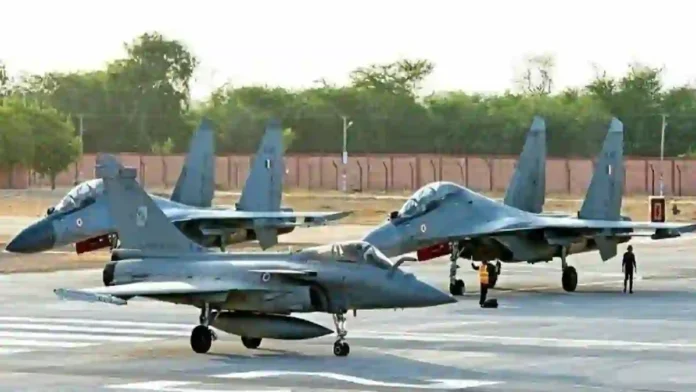The Indian Air Force (IAF) is now moving beyond its long-held benchmark of 42 fighter squadrons, a figure that was originally drawn up in a Pakistan-centric strategic context.
With strategic threats now shifting primarily towards China and the possibility of a full two-front war, top defence officials confirm that a thorough review has concluded that 42 squadrons will be insufficient, and the revised target will require significantly more aircraft, potentially pushing IAF’s sanctioned fighter fleet beyond 1,000 aircraft.
Read- Pak Concerns: India’s Continuous At Sea Deterrence Nuclear Fortress In The Indian Ocean
Currently, the IAF faces a worrying depletion in its operational squadrons, which will drop to 29 this month with the final phasing out of the MiG-21, accounting for only around 464-522 fighters—over 250 short of the older 42-squadron requirement and far below the new benchmark under consideration.
The present combat strength consists of 12 Sukhoi-30MKI squadrons, three Mirage-2000, two Rafale, two TEJAS, along with legacy Jaguar and MiG-29 squadrons. This shortfall becomes striking when compared to adversaries: China’s PLAAF fields over 2,000 frontline fighters, while Pakistan maintains a fleet of around 500.
Procurement and development delays severely exacerbate the IAF’s capability gap. The slow production pace of the indigenous TEJAS fighter has been a core problem, combined with the protracted nature of foreign acquisition processes.
The government has emphasised full self-reliance in fighter design, development, and production by 2047, but bridging the immediate deficit requires urgent parallel measures. India has already ordered 83 TEJAS MK-1A and sanctioned 120 TEJAS MK-2, alongside the development of 126 fifth-generation stealth AMCA fighters.
Read- An Unexploded Pakistani Fatah-1 Series Rocket Shell Recovered From Dal Lake
Read- Safran Submits Proposal To Manufacture Turbofans For TEJAS MK-2 Jets Amid Strained Ties With US
Parallelly, the 114 Multi-Role Fighter Aircraft (MRFA) program is being pursued on priority, with the French Rafale emerging as the frontrunner due to existing familiarity, shared tooling and infrastructure, lower induction overheads, and high readiness.
The Navy’s Rafale-M order further strengthens inter-service synergies, while the reduced bureaucratic hurdles in extending Rafale procurement provide a compelling case.
The IAF’s evolving doctrine shows a decisive pivot: from a Pakistan-focused force structure to one optimising for confrontation against China’s scale and technological edge.
This will demand not only a surge in squadron numbers but also rapid deployment of modern, networked platforms, indigenous production ramp-up, and streamlined acquisition mechanisms.
The combined pressure of PLAAF’s expanding footprint and Pakistan’s steady modernisation leaves India with a compressed window to close the fighter gap, making the next decade a decisive period for the IAF’s combat preparedness.
Based On The Week Report
Agencies




